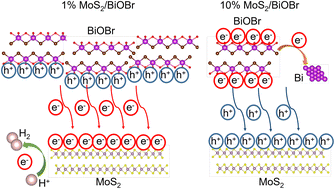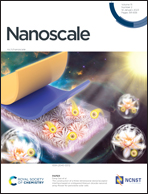2D MoS2/BiOBr van der Waals heterojunctions by liquid-phase exfoliation as photoelectrocatalysts for hydrogen evolution†
Abstract
As a semiconductor used for the photocatalytic hydrogen evolution reaction (HER), BiOBr has received intensive attention in recent years. However, the high recombination of photoexcited charge carriers results in poor photocatalytic efficiency. The combination with other photoactive semiconductors might represent a valuable approach to deal with the intrinsic limitations of the material. Given that BiOBr has a 2D structure, we propose a simple liquid-phase exfoliation method to peel BiOBr microspheres into few-layer nanosheets. By tuning the weight ratio between the precursors, we prepare a series of 2D MoS2/BiOBr van der Waals (vdW) heterojunctions and study their behaviour as (photo)electrocatalysts for the HER, finding dramatic differences as a function of weight composition. Moreover, we found that pristine 2D BiOBr and the heterojunctions, with the exception of the 1% MoS2/BiOBr composition, undergo photocorrosion, with BiOBr being reduced to metallic Bi. These findings provide useful guidelines to design novel 2D material-based (photo)electrocatalysts for the production of sustainable fuels.

- This article is part of the themed collections: Nanoscale 2023 Emerging Investigators, Nanoscale Horizons, Nanoscale, and ChemComm: Nanocatalysis and Celebrating International Women’s Day: Women in Nanoscience


 Please wait while we load your content...
Please wait while we load your content...